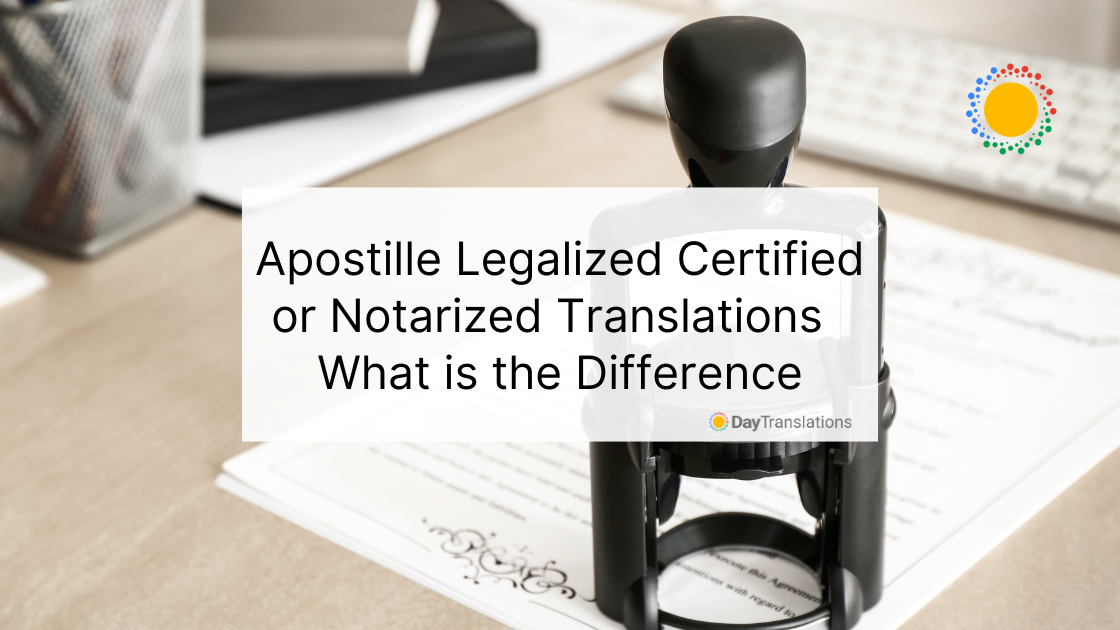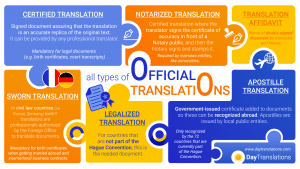Why Do I Need Certified Translations?
You might be familiar with a couple of these terms. You might have heard about them if a friend or a relative has moved or gotten married abroad, but what tends to happen with translation requirements and documents is that the lines between them get blurry, and the difference between these certifications gets hard to tell.
Throughout this article, we´ll analyze the precise definitions of these concepts and their implications, along with the general context in which they are often required.
There are several reasons why a translation might have to go through these procedures. Today, immigration is the most common. When traveling to a different country to start a new life there, a certified translation will probably be mandatory. Even if you don´t plan to spend more than 6 months away from home, during your application for a temporary visa in a foreign country like the U.S. it will be necessary to present your personal documents in English.
It is also common to find this sort of requirement when applying for a scholarship in a foreign country to study a post-graduate program. Colleges and universities –not only in the U.S. but also most of European academic institutions– ask every applicant to submit a certified translation of their transcript of records and diplomas.
If you apply for a working visa, usually the H.R. team will request criminal records and other legal documents that are not originally written in English to be sent and translated. Same thing will happen to entrepreneurs during the registration of a patent to protect IP rights. These are some of the possible scenarios where translated certifications will be indispensable.
Now, it’s time to learn the difference between the different kinds of translations so as to recognize what steps are necessary.
How Many Types of Translations Are There?
Here is a brief explanation of six elementary and commonly used notions:
What is a Certified translation?
A certified translation is the mean by which a translator or a translation company attests that the executed translation is a complete and accurate representation of the source text. In order to do this, a signed statement is issued declaring that the translation is a true reflection of the original document and each page has a stamp along with a certificate that verifies the translator´s credentials. Any professional translator or translation agency can issue a Certificate of Accuracy.
They´re usually requested when submitting legal documents and personal information such as marriage certificates, supporting documents for immigration, court transcripts or even business contracts. To get one, you won’t need a certified translator as one might imagine: since it´s a verification, any qualified translator or language service provider (LSP) may certify how exact the translation is through a Certificate of Accuracy.
Certified translations are also referred to as “sworn translations” since the completed translation is considered to have the same legal value than that of an official document in the eyes of administrative authorities (governmental or educational). This is why the document will contain a stamp, a unique registration number, date, and signature of the sworn translator.
What is a Notarized translation?
The point here isn´t the quality of the translation but the legitimacy of the translator. This translator will have to swear an oath before a Notary Public authorized by the government to authenticate certain legal procedures.
Therefore, notarized translations will only refer to the identity of the translation, overseeing his or her professional condition so as to be held accountable in case of irregularities. In notarized translations, the Notary Public will witness the certification process, and then include his/her signature and stamp along with the original text.
What is a Legalized translation?
Sometimes, if you have to send documents to a foreign country, these will need to be legalized. This doesn´t mean that the translation of the document is accurate, but it does corroborate whether the stamp on the document is genuine or not.
Legalization is the process of making an already authenticated document valid for use in a different country and it can only be carried out by the consulate of the country where the translated document will be used. This works in a very similar way than that of the notarized translation: during the legalization procedure, the consulate will not validate the content of the document, but the authority of the public official who signed the document previously.
Apostille
This specific type of certification will only be valid for those countries who are signatories of the Hague Convention. The Apostille Treaty of The Hague Apostille Convention is an international treaty that details the process through which a document issued in one of the signatory countries may be certified for legal motives in all the other signatory countries. That certification is called “Apostille”.
Its legitimacy equals that of a notarized document in domestic law. This means that any document with an Apostille stamp will be considered legal in every country that signed the Apostille Treaty.
Translator´s affidavit
This is one of the requirements that need to be included in a certified translation in order to be considered legitimate. A translator’s affidavit is an assurance that states the translator´s opinion that the text is in fact an accurate translation of the source text into the giving language.
The main purpose of an affidavit is to ensure that the translating work was done to the best of the translator´s knowledge and abilities. This declaration can only be carried out by the translator himself.
One step at the time
As seen in the last paragraphs, every document has its own definition and, therefore, its own set of requirements. During this part, we´ll take you through the main conditions and prerequisites you´ll need to follow to get what you need. Keep in mind that these stipulations depend on the particular legal observations and obligations of the country you´ll send everything to. So the specifications might change according to your chosen destination.
Regardless, here are some key points to keep in mind to examine a certified translation and how complete it is:
- Your original document must be entirely translated. Even if there are parts that are not clear, the translator should mark those as “not legible” and include them in the English translation.
- Chose a reliable professional translation services provider. If you´re in need of certified translation services we are here to help! We count with the necessary qualifications to translate from your source language to any language target you need.
- The look of the translated document has to match the appearance of the original one. If there are any seals or signatures, they need to be presented in the same places, imitating the distribution of the source piece.
- Remember, further steps might be necessary and that will solely depend on the country you´re going to. Legalization, apostille, among others. Verify these before you start.
- Talking about costs, most translators and LSP charge per word, per page or according to the number of hours that will take them to complete the translation process. Notary publics tend to charge per page and this fee is usually attached to the translator payment.
Think of the cost to each translated document, or interpreting time in court, as an investment that protects your interests. A wrongly translated document or interpreted testimony can bring a mistrial or with an innocent in jail. Check our free resource on language services and the legal industry to know more.













Sorry, the comment form is closed at this time.